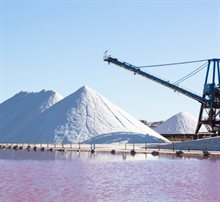Report ‘The Economic and Social Value of Salt’ (Dutch)
There are enough salt reserves in the world. Even if underground reserves were to be depleted in the distant future, there is always the salt in the world's oceans that, after processing, can meet the desired quality standards and be used for various purposes. But salt that can be extracted from the ground with the right quality immediately? That can only be found in a limited number of locations worldwide, including some places in the north and east of the Netherlands.
Strategic Importance of Salt
With the increased attention to the security of supply of important raw materials due to geopolitical tensions, the Ministry of EZK wants to know the economic and social significance of the salt mined in our country. The ministry also asked to look at the importance of salt in relation to the smooth progress of the energy transition. Among other things, the request was to look at salt as a raw material for batteries and the storage of hydrogen and other gases in salt caverns (these are underground cavities created during salt mining). So, there is more to salt than just its applications in the chemical industry and de-icing roads.
Focus on Salt Caverns
Van Bree knew he did not have to start completely from scratch, as TNO colleagues from the Geological Service of the Netherlands (GDN) have a lot of expertise in salt mining. These colleagues had just completed a social cost-benefit analysis (SCBA) on hydrogen storage in salt caverns and had come to very interesting insights. "They advise starting large-scale salt mining as soon as possible. And it's not so much about the salt, but about the empty salt caverns that are created and are well-suited for storing hydrogen. As it stands now, large-scale storage capacity for that gas will be an important condition for accelerating the energy transition."
Alternative to Natural Gas
Now that the decision has been made to definitively close the natural gas tap in Groningen, a transition to hydrogen seems a logical choice, especially for the industry. That gas can be made by running electric current through water: a process that takes place via electrolysis devices and does not involve natural gas or other fossil fuels. Given the rapid expansion of wind farms in the North Sea and the gas pipelines already present in many places, all conditions are in place to produce and transport large quantities of green hydrogen. Not all that hydrogen can be used immediately. It is important to have enough of that sustainable energy carrier in stock for periods of increased energy demand.
12 Billion Euros in Social Benefits
To provide the necessary hydrogen storage capacity, underground storage in salt caverns is currently the best-developed technology, Van Bree now knows. "And the GDN colleagues advise in their SCBA to create 30 to 60 such storage facilities in the Netherlands. It shows that hydrogen storage in salt caverns can yield over 12 billion euros in net social benefits. These benefits are even positive if the mined salt is not used for industry or other applications.
In Germany, they are already aware of this: to quickly create as many salt caverns as possible, they discharge salt brine directly into the North Sea. This is not allowed in the Netherlands, and it is also questionable to what extent these discharges affect the environment. But I found it surprising to discover during a study on the value of salt that the storage capacity of salt caverns is so important for the energy transition and so valuable that salt could suddenly become a by-product."
Raw Material for Industry
Back to the salt itself. What is the Dutch salt reserve currently used for? "Mainly as a raw material for the chemical industry," Van Bree learned. "Electrolysis of a salt solution is the only way to make chlorine."
In addition to chlorine, caustic soda (sodium hydroxide) and hydrogen are also produced during the electrolysis process. These three products all play an important role in the industrial production of, for example, PVC, paper, medicines, insulation materials, aluminium, soap, soda, glass, paint, and textiles. Moreover, the salt mined in the Netherlands is of such high quality (purity) that little additional processing of the salt is needed for industrial production processes.
Development of Salt Batteries
Salt processing in the industry consumes a lot of energy. The cost price of this, together with the sustainability challenge and international competitive pressure, creates uncertainties in the long term. Van Bree also considers that the use of bulk salt in the Dutch industry may decrease and therefore tried to find out which sustainable applications of salt are possible in the future.
"In the current production of lithium-ion batteries, salt plays an indirect role due to the use of caustic soda. No large volumes of salt are needed for this. But in the meantime, work is being done in various places on heat storage based on salt, which does require a lot of salt. I also spoke to experts who indicated that salt batteries could be a potential alternative to lithium-ion batteries. These are mainly larger, stationary batteries that can be used for storing electricity generated by solar panels and wind turbines. So, promising developments are also taking place in this area."
Social Discussions
"In the Netherlands, there are two regions where salt can be mined: in Twente and in the north of the province of Groningen," Van Bree indicates. "And in that last province, the earthquake problems caused by natural gas extraction play a role, making plans for underground activities quite sensitive. As a result, people also express their concerns about salt mining and the storage of hydrogen in salt caverns. However, the risk of damage from subsidence or vibrations due to salt mining or gas storage in salt caverns is very small.
There is no reason to assume that there are major safety risks. This does not, of course, negate the fact that public perception and people's concerns must be taken seriously and need attention. I am very curious about how the decision-making process around hydrogen storage and salt mining in the Netherlands will proceed and will, of course, follow developments closely."
The Hague Takes Action
In the Contourennota Mijnbouw, it was announced that the Cabinet will come up with a vision on the future of salt mining in the Netherlands. The (re)use of salt mining locations for energy storage in the future energy system is designated as a national interest in the structural vision for the subsurface.
The Cabinet wants to use the development of new salt caverns as a starting point, where technically and financially possible, to take into account the possibility of using these caverns for hydrogen storage in the future. Both the SCBA report from the GDN colleagues and the report from TNO Vector can help make a well-considered decision.





